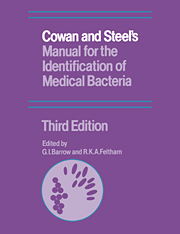Book contents
- Frontmatter
- Contents
- Foreword
- Preface to the first edition
- Postscript
- Preface to the second edition
- Preface to the third edition
- List of contributors
- Introduction
- 1 Classification and nomenclature
- 2 Culture media: constituents and sterilization
- 3 Principles of isolation
- 4 Bacterial characters and characterization
- 5 Theory and practice of bacterial identification
- 6 Characters of Gram-positive bacteria
- 7 Characters of Gram-negative bacteria
- 8 Taxonomy in theory and practice
- 9 Bacterial identification by cards
- 10 Bacterial identification by computer
- 11 Quality control in microbiology
- Appendices
- A Preparation and control of culture media
- B Staining: reagents and methods
- C Characterization tests
- D Test organisms
- E Preparation and use of Identicards
- F Use of computers
- G The Bacteriological Code
- H The Approved Lists of Bacterial Names
- I Reconciliation of Approaches to Bacterial Systematics
- J Glossary
- References
- Index
G - The Bacteriological Code
Published online by Cambridge University Press: 15 December 2009
- Frontmatter
- Contents
- Foreword
- Preface to the first edition
- Postscript
- Preface to the second edition
- Preface to the third edition
- List of contributors
- Introduction
- 1 Classification and nomenclature
- 2 Culture media: constituents and sterilization
- 3 Principles of isolation
- 4 Bacterial characters and characterization
- 5 Theory and practice of bacterial identification
- 6 Characters of Gram-positive bacteria
- 7 Characters of Gram-negative bacteria
- 8 Taxonomy in theory and practice
- 9 Bacterial identification by cards
- 10 Bacterial identification by computer
- 11 Quality control in microbiology
- Appendices
- A Preparation and control of culture media
- B Staining: reagents and methods
- C Characterization tests
- D Test organisms
- E Preparation and use of Identicards
- F Use of computers
- G The Bacteriological Code
- H The Approved Lists of Bacterial Names
- I Reconciliation of Approaches to Bacterial Systematics
- J Glossary
- References
- Index
Summary
For scientific purposes, the naming of living organisms requires rules to ensure standardization and consistency in nomenclature and thus in the unequivocal communication of identity. The necessary scientific rules for naming all living organisms are embodied in international codes of nomenclature. Separate codes have been formulated for animals, plants, bacteria and viruses. The rules governing the application and use of names for bacteria were long overdue before they were promulgated in the first Bacteriological Code approved in 1947 (Buchanan, St. John-Brooks & Breed, 1948). This code, which was largely based on the Botanical Code, was both long and complicated. Subsequent attempts to increase its usefulness resulted in further difficulties despite the accompanying explanations given in the revised versions published in 1958 (Buchanan et al., 1958) and in 1966. Such rules are necessarily framed in legalistic language, which is not always easily understood. The Bacteriological Code has two basic guidelines: (i) to avoid translation into different languages, all names must be Latinized so as to be clearly recognized both scientifically and internationally and (ii) the names must have definite positions in the relevant taxonomic hierarchy.
Informal or vernacular names for bacteria such as ‘coliform organisms’ and the ‘tubercle bacillus’ are not governed by the Code although it may help to regulate their use by recommendations for good practice. Informal names such as those for organisms which differ only antigenically are governed by separate rules.
Scientific names are used for species, genera and higher ranks.
- Type
- Chapter
- Information
- Publisher: Cambridge University PressPrint publication year: 1993



